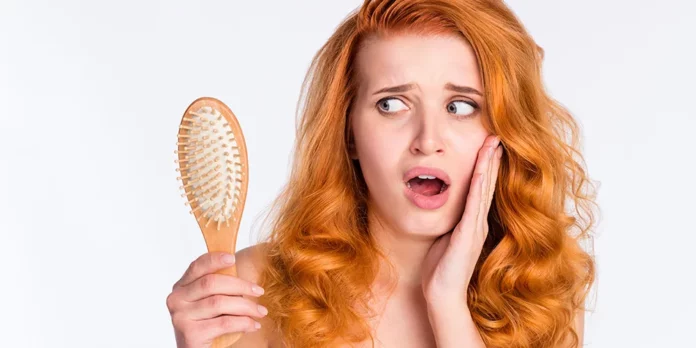Minoxidil is one of only two drugs approved by the FDA to treat male pattern baldness — the other being finasteride. Available in both topical and oral forms, it’s proven to promote hair growth in male and female pattern baldness. (Note that, for the purposes of this article, terms like “male” and “female” refer to biological sex.)
As a topical treatment, minoxidil is available as either a foam or a solution. The ideal concentration for most people with male pattern baldness is 5%. Topical minoxidil needs to be applied to the scalp twice a day, every day, in order to be effective.
Oral minoxidil, an off-label treatment available by prescription, is usually taken as a once- or twice-daily pill. Some people prefer oral minoxidil because it’s less messy and doesn’t alter hair texture, as topical minoxidil sometimes can.
Results from minoxidil treatment usually start to show after around 4-6 months of regular use. Users need to keep using minoxidil indefinitely to continue regrowing their hair.
How Effective Is Minoxidil?
Topical minoxidil is considered to be over 90% effective at reducing and stopping further hair loss. It can also increase hair growth by over 35%. It’s so effective that one of its main side effects is that it can cause unwanted hair growth. You need to be careful when you apply it, or you could end up with random new patches of body hair.
Oral minoxidil has about the same effectiveness as topical minoxidil, but it’s more likely to cause side effects. That’s why it’s not usually the first option most hair loss treatment providers turn to. The side effects of oral minoxidil can include headaches, fast heart rate, ankle swelling, and low blood pressure.
What Makes Minoxidil So Effective?
To be honest, scientists aren’t exactly sure which traits of minoxidil make it so effective. But it has a number of properties that could play different roles in helping hair grow thicker and faster. Here are some of the mechanisms of action — science speak for “ways it works” — behind the power of minoxidil.
It Improves Blood Flow
Minoxidil is considered a vasodilator: a drug that expands (dilates) blood vessels, increasing blood flow and lowering blood pressure. Vasodilators help the body deliver more oxygen and nutrient-rich blood throughout cells and organs. It’s believed that this delivery of oxygen and nutrients to hair follicles helps stimulate them to grow healthy hair.
The vasodilation effects of minoxidil may play a role in some of the other mechanisms by which minoxidil encourages hair growth. For instance, it may help reverse the course of follicle miniaturization.
It Opens Potassium Channels
In addition to dilating blood vessels, minoxidil also works as a potassium channel opener. Potassium channel openers act on the vascular muscles to increase blood flow. In other words, as with vasodilation, blood vessels expand, allowing more nutrient-rich blood and oxygen to be delivered to hair follicles.
Potassium channel openers have been shown to stimulate hair growth in stumptail macaques, a type of primate. These drugs include minoxidil as well as cromakalim and nicorandil, all of which are also used to lower blood pressure.
It Slows and Reverses Follicle Miniaturization
Follicle miniaturization is when hair follicles get narrower over time, causing them to produce gradually finer and more fragile hair. Over time, miniaturization causes hair thinning, hairline recession, and balding. The exact mechanism is unclear, but what is known is that minoxidil can slow and even reverse this narrowing of the follicles.
When follicles are wider, hair is able to grow thicker. This makes it less brittle and vulnerable to breakage. Hair from severely miniaturized follicles is prone to falling out because the shaft — the visible part of the hair — is so weak.
It Shortens the Resting Phase
Another way that minoxidil works is by shortening or speeding up the telogen, or “resting,” phase of the hair growth cycle. The telogen phase is typically about three months long. In clinical trials with rats, minoxidil shortened the telogen phase from about 20 days to just one to two days. It does this by stimulating the outer part of the hair follicle, also known as the “secondary germ.”
Speeding up the telogen phase can cause thinner, more brittle hairs to shed. That’s a good thing: Thicker, healthier new hair will ultimately grow back in its place. Patience is required, though, as this can take several months.
It May Extend the Growth Phase
In addition to shortening hair’s resting phase, minoxidil may also prolong the growth, or anagen, phase. This gives hair more time to thicken, develop, and grow. During the anagen phase, hair normally grows at a rate of about half an inch every month.
An ordinary anagen phase lasts anywhere from two to six years. To date, no study has definitively proven that minoxidil extends this timeline. But minoxidil may have a stimulatory effect on cell growth that delays aging of the hair follicles. It’s hypothesized that this phenomenon keeps the follicles in this growth stage for longer.
What’s Important Is That It Works
More research is needed in order to determine exactly what makes minoxidil so effective. But the important thing to keep in mind is that it does work. Multiple scientific studies have demonstrated how well minoxidil serves to regrow hair. There’s also lots of anecdotal evidence of hair regrowth in patients who were on minoxidil to treat other health conditions.
With proper, consistent, daily use of the right dosage of minoxidil, your hair really can grow back. In pill, foam, or solution form, minoxidil can increase your chances of keeping a fuller, healthier head of hair.


